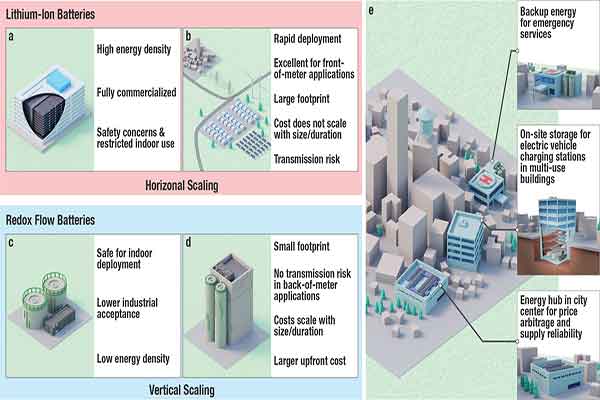- Lithium-ion and water-based batteries, including redox flow batteries, are being employed in grid-scale energy storage systems (BESS) to address the intermittence of renewable energy sources.
- The article highlights that safety, scalability, and cost considerations are more critical for large installations than the often-emphasized metric of energy density.
- Water-based batteries, being nonflammable, could be ideal solutions for applications in densely populated areas or where vertical scaling is required, opening new opportunities for sustainable energy storage.
With the sun’s rays providing energy during the day, we must have energy storage systems in place to ensure that energy remains accessible when it is needed most, like in the evenings. As wind energy is unpredictable, there has been a massive installation of lithium-ion battery containers to make up the difference in power grids globally.
In a recent case, the California Independent System Operator (CAISO) successfully used their battery system during a heat wave. Their batteries provided a substantial 3.3 GW or 6.8% of the overall power supply, ensuring the grid remained stable and averting possible blackouts in California, where renewables play a significant role.
Battery Location Dilemma
Where these batteries are placed poses a question. Many grid-scale battery energy storage systems (BESS) are situated in rural areas, often near vast solar farms where land costs are low and safety risks are minimal. However, densely populated areas will also require large BESS installations.
The need for energy varies across the grid, and if it can’t move freely to where required, costs can spike. BESS near critical grid points can manage congestion without the expense of constructing new transmission lines.
Battery Chemistry: A Critical Consideration
When installing megawatt-scale batteries in residential areas, their safety becomes paramount. Lithium-ion batteries are known to be safe, with failures reported as less than 1 in 10 million. Yet, when considering the 150,000 individual batteries in each BESS unit, the risk increases, with unit failure rates closer to 1 in 1,000. Such failures could lead to significant hazards like fires and explosions.
Water-Based Solutions
Water-based electrolytes are emerging as a promising solution. These aqueous battery chemistries are inherently nonflammable but often come with lower energy density than lithium-ion batteries.
One such technology is redox flow batteries. They are scalable and use nonflammable, water-based liquid electrolytes. While low energy density has been seen as a limitation, in reality, for large installations, this factor may not be as critical.
Is Energy Density Important?
The focus on energy density may be misplaced for grid-scale applications. Research indicates that cell-level energy density may not be as vital as previously thought for large installations. Satellite imaging has shown that energy capacity per area is often comparable between lithium-ion and flow batteries, even though cell-level differences are significant.
Conclusion
Water-based batteries may be viable options where vertical scaling is needed due to land constraints. Their nonflammable nature makes them suitable for deployment in populated areas or multi-use buildings, opening opportunities that remain closed to lithium-ion BESS.
There is no universal battery technology perfect for every use case. The time has arrived for solutions that prioritize safety, megawatt-scale efficiency, and a focus on cost, lifetime, scalability, automated manufacturability, recyclability, and supply chain safety, rather than solely emphasizing energy density. The world of battery technology is vast and rapidly evolving, and understanding the real needs of large-scale energy storage may help us unlock doors to more sustainable energy solutions.
—
Publication Referenced in the Article:
David Reber et al, Beyond energy density: flow battery design driven by safety and location, Energy Advances (2023). DOI: 10.1039/D3YA00208J












Comments